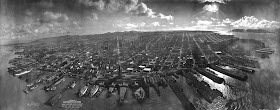George Lawrence. Online photo.
In 1896, Lawrence opened a photographic studio in Chicago with the motto: "The hitherto impossible in photography is our specialty."
One day while walking along Chicago's Michigan Avenue, Lawrence observed a kite trailing an advertising banner. This inspiration led him to develop cameras which could be taken aloft by kites. (As early as 1895, another American photographer, William Eddy, experimented with this idea).
Lawrence with his kite camera.
Lawrence's new kite cameras were suspended below 5 to 17 kites. With his kite-flying cameras, he took aerial photos around the region including at the U.S. Army Post Fort Sheridan, North Chicago, Zion, Waukegan and Rockefeller (Mundelein).

Fort Sheridan 1908 by George Lawrence. Library of Congress.

Rockefeller (later Mundelein) about 1906 by George Lawrence. Library of Congress.

Zion parade about 1906 by George Lawrence. Library of Congress.

San Francisco Ruins, May 28, 1906 by George Lawrence. Library of Congress.
The panoramic, kite-flying camera created a photograph of San Francisco so stunning in detail, clarity and objectivity of the disaster that it became famous and was reprinted many times. Sales of the photo earned Lawrence $15,000 (equivalent to $300,000 today).
In 1909, Lawrence abandoned photography to design and build airplanes. After World War I, government contracts for airplanes declined and Lawrence turned to analyzing lenses.
Lawrence pioneered aerial photography before airplanes were able to fly high enough to capture the spectacular photographs he took with his "kite cameras." He is also known for building the world's largest camera in order to photograph the Chicago and Alton Railroad's new passenger train. To capture the entire train in one photo, Lawrence used a glass plate negative measuring 56 x 96 inches.
In 1909, Lawrence abandoned photography to design and build airplanes. After World War I, government contracts for airplanes declined and Lawrence turned to analyzing lenses.
Lawrence pioneered aerial photography before airplanes were able to fly high enough to capture the spectacular photographs he took with his "kite cameras." He is also known for building the world's largest camera in order to photograph the Chicago and Alton Railroad's new passenger train. To capture the entire train in one photo, Lawrence used a glass plate negative measuring 56 x 96 inches.



How high did the kites go before he triggered the shutter? How long was the exposure? Do you have originals and may they be seen in person? Great posts keep up the good work.
ReplyDeleteThe photo of San Francisco after the quake was taken from a kite 2,000 feet in the air! The museum has a couple of Lawrence photos in the collection -- an aerial of Fort Sheridan, and a portrait of the Sioux warriors brought to the Fort after the Tragedy at Wounded Knee. Thanks for reading and commenting!
ReplyDeleteThe Zion photo was taken in 1904 upon the return of Dowie after a world-tour. Source: Zion City, Illinois: Twentieth-Century Utopia written by Philip L. Cook.
ReplyDeleteLawrence took photos in Zion from 1900 through 1904 at the least.